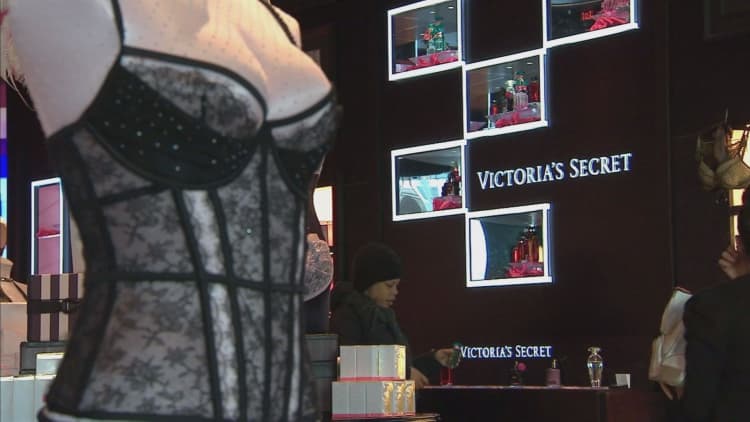
It would appear Victoria's Secret has some very satisfied customers.
Shoppers at the $7.67 billion lingerie chain, which controls roughly two-thirds of the country's intimate apparel market, make more frequent purchases than the average intimates consumer, according to Checkout Tracking, a service of The NPD Group.
They also spend more. Victoria's Secret customers shell out an average $40 to $60 more than the average intimate apparel shopper, aided by higher prices, the data found.
Checkout Tracking pulls its data from customer receipts.
"The exclusive and differentiated merchandising mix that Victoria's Secret offers shoppers has led to a unique breed of consumer that is extremely loyal," Marshal Cohen, chief industry analyst at The NPD Group, said in a statement.
NPD's report comes as several major retailers zero in on its shopper base. The popularity of easier-to-construct, lower-price bralettes has made it possible for less technically savvy brands to grab a toehold in the space.
Companies including Old Navy and Aerie are pressing into the category, leading to what Jefferies analyst Randal Konik coined a "bra war." Aerie is considered Victoria's Secret's biggest challenger for bralette spending, and has built its brand upon a contrarian approach to marketing.
Whereas Victoria's Secret is frequently criticized for using Photoshop on its models, Aerie has pledged an unretouched, body-positive campaign. It has also challenged the brand through a series of price promotions. Aerie's comparable sales grew 24 percent in the fiscal second quarter.
"We see the competition in this space continuing to increase, and pricing competition likely remaining steep," Konik told investors Monday.
Wall Street skeptics worry the popularity of bralettes could make it more challenging for Victoria's Secret to grow its own topline, as the lower-price items could pull spending from its more elaborate styles.
But Morgan Stanley analyst Kimberly Greenberger isn't buying into that theory. Following a meeting with the company's management, Greenberger told investors last week that younger bralette shoppers are also buying more constructed bras.
Meanwhile, Victoria's Secret's push into bralettes has helped lower the average age of its customers by more than a decade, to 32, in just four months. Younger customers not only shop the brand more frequently, but also speak to its lasting potential, Greenberger said. Because bras are a difficult category to shop for, shoppers tend to stick with brands they've bought from in the past.
Victoria's Secret is likewise gunning for a larger piece of the growing sport business, after deciding to exit the stagnant swim category earlier this year. While some on Wall Street have questioned this shift, Greenberger noted that sport items are purchased more frequently than bikinis and during all seasons.
As a result, it was the "right long-term decision for the health and financial success of the brand," she said.
Greenberger pegs the company's opportunity for sport at $1 billion, compared with an estimated $250 million to $300 million at the end of last year. The swim business accounted for an estimated $400 million at the end of 2015, flat with 2012, Greenberger said.
Victoria's Secret's sales grew 3 percent in the fiscal second quarter, to $1.87 billion. Its margins took a hit from higher clearance levels, which were tied to the merchandise categories it will no longer sell.


